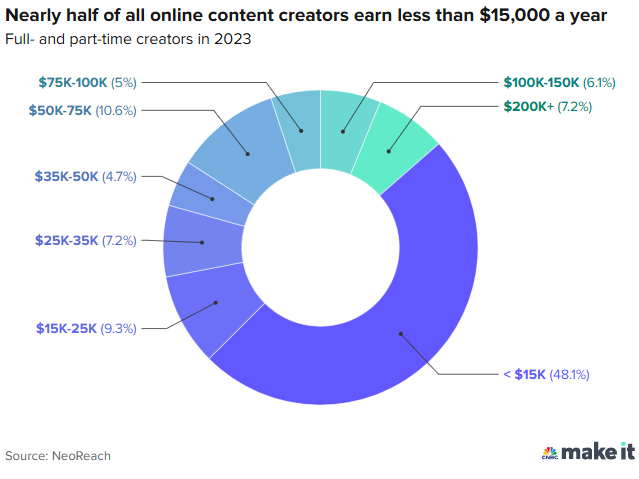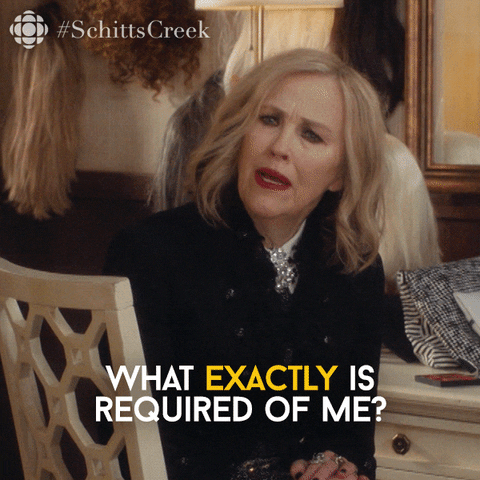Influencer Series Pt. 2
"So you want to be an influencer?" Master these 8 steps before reaching out to collab with a brand, and you'll be an instant favorite go-to partner.
Let's start with a stat
More than half of Gen Zers want to be influencers — 57% according to a 2023 Morning Consult survey (and I'm willing to bet it's even higher in 2025). But let's look at a stat that may make aspiring influencers cry: the income reality.
Pursuing being an influencer full-time is a ton of work with most making very little income, certainly not a livable salary. See the graphic below: Nearly half of all content creators earn less than $15,000/year.
Just something interesting to consider if you’re out there trying to become an influencer — know that the competition is fierce. So if you master the below eight steps, you’ll be lightyears ahead and GET lightyears ahead of your aspiring peers.
Let's get into the meat of it.
What makes an influencer appealing to work with for brands?
This should be a no-brainer, but your outreach to brands needs to be personalized, sensical and intelligent. I can't tell you how often I would get cold emails from influencers who had a ton of…
Spelling and grammar errors (doesn't inspire confidence in your caption writing abilities)
Clearly copy and pasted the whole, vague email (and sometimes forgot to swap out the brand name!)
And don't have a clear CTA/next step/ask
Reach out with a media kit already linked (and not attached — link to it on a Google Drive or anywhere else). What should be in an influencer's "media" kit?
Your up-to-date stats across platforms (followers/views)
Your audience demographic data
Your content focus/niche
Case studies of past relevant brand partnerships (this means the actual post/campaign stats, not just the posts)
Last but most certainly not least, your rates — and get specific. Most marketers know influencers of a certain caliber aren't willing to work on trade anymore, but if you ARE, you're wise to use this as a foot-in-the-door method at the very least. We know working on trade doesn't pay the bills, but you are immediately more appealing to work with if you don't charge for content.
Specify if you also charge for licensing/usage rights, specify your rates per platform, per content type, per length of content for videos/highlights, etc. etc. SPE-CI-FY!
Do your research on the brand you want to partner with FIRST. This goes back to #1, personalizing, but that doesn't just mean swapping out "Sephora" with "Ulta." The more you come to the "table" knowing, the more likely the brand will be interested in partnering with you. Not to mention if you're a genuine fan of the brand/experience/destination — always, always mention any personal experience/affinity (even better if it comes in the form of a story) you have in connection with the brand.
Reach out with creative content ideas. The people influencers are reaching out to are, most assuredly, extremely busy people. You make their lives easier when you don't force them to come up with a creative partnership/content idea for YOU, and instead offer up some proactively.
With Chat GPT, there's no excuse anymore. Especially if you're reaching out to a well-known brand like Nike, Apple, Disney, etc. Chat will have plenty of ideas. Just remember to fact-check and filter those ideas through the brand's reality, the state of the industry and the state of the world.
Reach out with enough lead time. An influencer recently cold-reached out to me five days before (Monday) she was going to be in San Luis Obispo (my client) offering to partner while she’s in town for the weekend (Sat-Sun). Guess what happened?
I replied within 45 minutes asking for all the stuff we would need first (like a media kit and rates *cough cough*) and she didn’t get back to me until Wednesday at 4 p.m. Then Thursday and Friday were hectic, and before you know it, it's Monday. We couldn’t partner with her. Not enough lead time.
The same goes for timely content ideas such as holiday themed, season-specific, and national “days” (i.e. National Rosé Day).
Keep all your engagement public. Meaning, don't hide likes/views/comments etc. The first thing marketers like me do after getting your initial outreach email is 1) look at your profiles — please for the love of god link them in your email and 2) throw those profiles into a tool like CreatorIQ, Hypeauditor, Modash, etc. to look up your ER, fake follower percentage and audience data. Yes, we can see how many followers of yours are fake.
Oftentimes, if your likes are hidden, we won't even consider partnering with you because we have no way of verifying these stats through a third-party like my favorite, Modash. So, if you hide likes, your ER on these influencer look-up platforms will be null "--%". The influencer I mentioned in #5 had hidden likes so that was one of the things I had to ask for as well, was screenshots of stats from her most recent partnerships (and she gave them to me in writing, not a screenshot, in her reply — defeating the purpose altogether)
Have your location and email in your Instagram bio (or TikTok, X, Facebook, Pinterest, etc.). This is a BIG one influencers flub all the time. Eliminate any barriers to partnering with you. And oftentimes, that's these two simple things a marketer needs upfront.
Bonus: Know the lingo AND each platform's latest capabilities, algorithms and legal guardrails.
Lingo like: reach, engagement / ER = engagement rate, IMPs (impressions), CTR, affiliate links, brand ambassador, licensing, earned vs. paid media, (product) seeding, sponsored, UGC, KPIs, ROI, etc.
Capabilities: Follow Annie-Mai Hodge on LinkedIn for weekly/sometimes daily updates across social platforms, and/or keep up with industry leaders who publish updates and takeaways as well like Sprout Social, Hootsuite, Brandwatch and of course, each platform's own newsroom/creator guides. The more you know, the more creative your proposed content ideas can be, and marketers always appreciate more out-of-the-box creativity in influencer campaigns.
Algorithm updates can usually also be found wherever capability/feature updates are, but this means, what is the platform favoring in content it's serving to users?
An important one to be crystal clear on: The legal way to indicate you're being paid for a post (#ad, "sponsored," "gifted," "hosted," and more) or if you're partnering with a vice-brand (alcohol, booze, gambling, cannabis, etc.) they have a whole other host of legal guidelines to follow (and platforms like Meta are extremely strict and often reject posts initially, causing a delay in posting and an appeals process that is simple but time-consuming due to a human-approval process)
That’s all for today — stick with me, another post will be coming soon before I head off to Italy for two weeks under the Tuscan sun (and Venice!).







